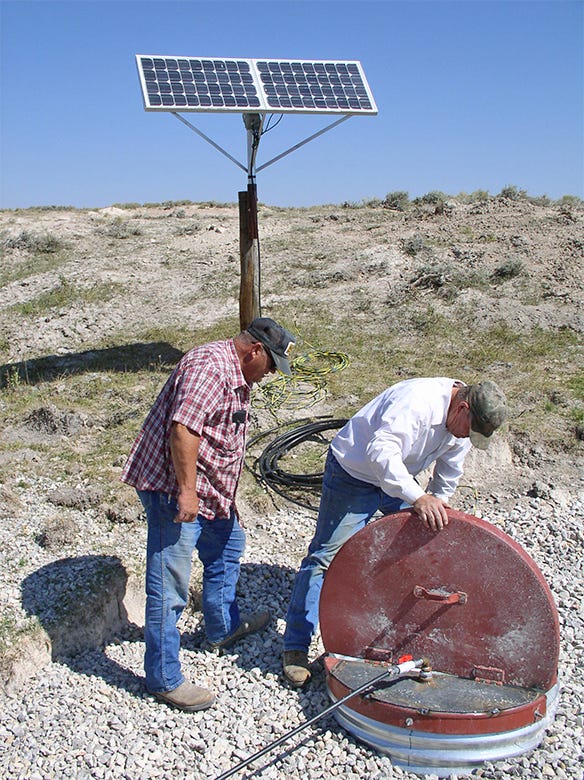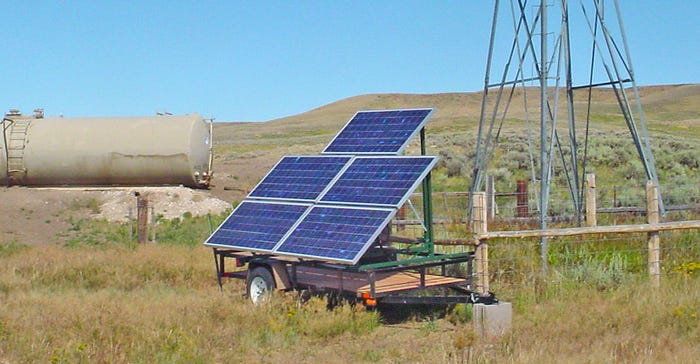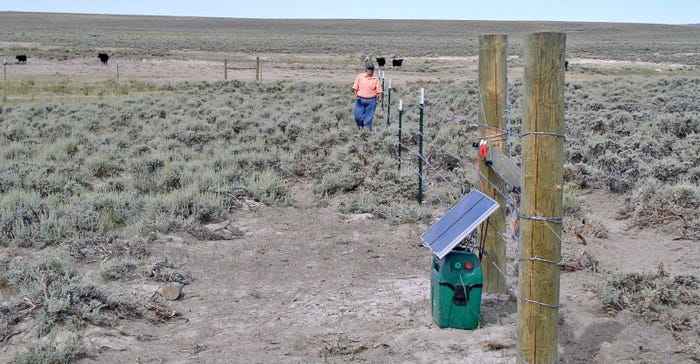March 28, 2018

Editor’s note: This is the fifth story in a series exploring how ranchers and farmers are benefiting from renewable energy.
More ranchers across the arid West are using solar-powered spring and well developments to make their operations more sustainable, during both periods of drought and normal precipitation.
Among them is Todd Heward, whose family ranches on the high desert and plains of southeast Wyoming.

WELL CHECK: Ron Heward, right, and a BLM employee examine a newly installed spring box and solar pump on the Heward family ranch in southeast Wyoming. Shortly after this photo was taken, Ron Heward was diagnosed with cancer; he passed away in 2016 after a six-week battle. His son, Todd, now manages the ranch. (Photo courtesy of Todd Heward)

“About a decade ago we started developing springs, wells and pipelines that were meant to provide supplemental water, but without those we couldn’t have existed the past few years because of some extreme droughts,” Heward says.
“Historically, we survived on rain and snowmelt that fed 36 reservoirs across our ranch, but lately only about five or six have had water in them after four years of drought,” he continues. “If it hadn’t been for our water developments, the last several years would have been a financial disaster for us.”
The Heward ranch is in the desolate Shirley Basin, which receives, on average, only 7 to 9 inches of precipitation each year. But when Mother Nature dished out only 5 or 6 inches in recent years, the water developments allowed the Hewards to avoid major destocking.
“All but one of the developments are solar-powered. With the advances in solar systems, panels and pumps are cheaper and more efficient, and you can pump deeper wells now,” he notes. “In fact, with one solar system we’re pumping water from a 300-foot-deep well and pushing that water one-half mile uphill to a storage tank. We’re only getting about 3 gallons per minute, and that’s why we installed a 48,000-gallon tank.”

PORTABLE POWER: This trailer-mounted system can be moved from pasture to pasture to power solar wells on the Heward ranch in southeast Wyoming. At this particular site, the portable system has replaced an old, higher-maintenance windmill. A solar pump was installed in the well below the windmill stand, and a large storage tank holds water pumped from the well. (Photo courtesy of Todd Heward)

Supporting cattle
The Hewards run 300 cow-calf pairs, 150 yearlings and 600 sheep on about 28,000 deeded and leased acres, and they lease another 12,000 acres to other ranchers. “We decided to start leasing some acres out as part of our drought management plan,” Heward says. “We sign three-year contracts, and the lessees understand that there’s a possibility they will have to remove their cattle if we’re moving into a drought. We understand that’s not ideal for them, but it’s part of our ‘insurance plan.’”
Nine well and spring developments, which are powered by either permanent solar systems or trailer-mounted portable units, have also been a key component of that plan. The family is in the process of developing four more wells, two of which will be permanent solar.
“We used to have two large pastures and had no drought management plan, and in some years, we were overgrazing — especially in key places like riparian areas,” Heward says. “The pastures were so big that we would keep cattle in them for 50 to 60 days, and the cattle would tend to camp out in the riparian zones instead of utilizing the uplands. Some areas were simply not getting adequate recovery time.”

THIRSTY COUNTRY: Solar-powered wells provide much-needed water for cattle on the Heward ranch in southeast Wyoming’s high desert and plains. The well casing, left, and solar panels and controls, right, are fenced in to prevent damage from wildlife and livestock. This permanent system is attached to 2 miles of underground pipeline, a storage tank and troughs. (Photo courtesy of Todd Heward)

Heward says that the water developments —in combination with 17 miles of pipeline, water storage tanks and the use of both permanent and portable electric fence — have allowed them to divide the ranch into 28 pastures.
These efforts have enabled the family to implement an intensive rotational grazing system, and the condition of rangelands and riparian areas has improved dramatically. Heward says that he looks at running a ranch like putting together a big puzzle, where every piece, from calving and range management decisions to solar-powered well and spring developments, is integral to success.
“Our livestock and range have come out of the last several droughts in pretty good shape, and that tells me a lot,” Heward says. “That’s a telltale sign that we’re doing things right.”
Renewable energy key component of ranching
There are several large commercial wind farms on private and public lands in southeast Wyoming, and it’s Heward’s hope that one day a commercial farm will be built on his family’s ranch.
He, along with his wife, Malea, and seven children are doing everything they can to make their family ranch succeed, whether trying to attract a commercial wind project or put a couple of small solar panels to good use throughout the year.
The Hewards have assembled three trailer-mounted solar systems to power spring and well developments across their sprawling ranch. When the portable units aren’t pumping water for cattle and sheep, they are being used for other purposes.
“We are using them to pump water to irrigate pastures, and we’re also using them to provide water for our hoop houses,” Todd Heward says. “That enables us to grow many vegetables and fruits, which we eat fresh and also can.”
And during the winter, he notes, “We heat a storage room and our veterinary room with the portable solar units by hooking up a solar inverter to a small heater.”
The Hewards, along with many ranchers across southern Wyoming, operate in an area that has both ample sunshine and wind. Some operators in the area are installing solar-wind turbine combinations to pump stock water.
“So if it happens to be cloudy, you hope there is enough wind to operate the pump,” he says.
In this part of Wyoming, that’s typically not a problem — attested by the growing interest in commercial wind energy.
“We have discussed the development of a commercial wind farm on our ranch with two companies, including Invenergy, which installed two METs on our land,” says Heward, referring to the meteorological evaluation towers that help companies verify wind characteristics at the site of a potential wind farm.
Many ranchers in the Western Farmer-Stockman area are familiar with Invenergy, which has developed commercial wind projects in Idaho, Montana, Oregon and Washington.
“There is definitely potential in our area, and we continue to follow the commercial wind energy industry pretty closely,” Heward says.

FENCE OUT: Marji Patz with the Natural Resources Conservation Service inspects a newly installed water gap and electric fence on the Heward ranch in southeast Wyoming. A portable solar energizer supplies power for a single strand of electric fence, preventing cattle from entering a riparian area. (Photo courtesy of Todd Heward)

Grazing plan bolstered by solar water developments
The development of solar-powered wells and springs in combination with other management decisions is enabling Heward and his family to operate a much more efficient, sustainable ranch on the parched plains and high desert of southeast Wyoming.
The water developments have allowed the family to better manage grazing, and they are now using a grazing response index to monitor each pasture. This index is based on the frequency of grazing (how many times a plant is defoliated in one year), the intensity of grazing (amount of use), and the opportunity a plant is given to regrow before dormancy.
“Our grazing plan is based on full recovery of grass during the growing season,” Heward says. “We really strive to keep our pastures in the top scores of 3 and 4. The 4s are our bank, and the bank has absolutely helped us during droughts.”
Heward is referring to a forage bank, and he emphasizes that during years of extreme drought, up to 65% of the forage their livestock use is from the previous year’s growth.
“We’re trying to build security so we don’t have to destock in most drought situations,” he says.
Their rangelands have improved dramatically over the past decade, and during normal precipitation years they could probably run more livestock. But Heward says his goal is to continue to enhance forage resources, which is benefiting both wildlife and livestock.
“Despite moving calving later in the spring, we’re weaning more pounds of calves,” Heward says. “The calves are being born on green grass, and they are a lot heathier than they used to be. Also, the birth rates are higher, and we’re losing fewer calves because we’re not fighting those early-spring storms.”
The mother cows are healthier, too, and this took an integrated approach that was made possible, in part, by the solar-powered water developments.
Waggener writes from Laramie, Wyo.
About the Author(s)
You May Also Like




